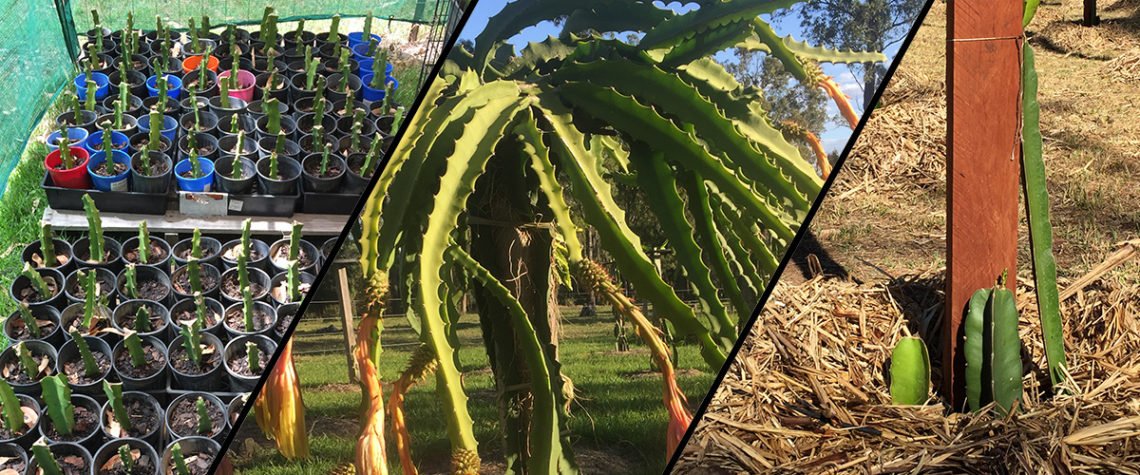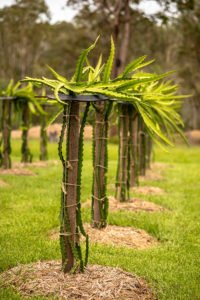
Cultivation
Dragon Fruit plants are a hardy tropical cactus that are grown in a wide range of climates and countries. Learn how to grow Dragon fruit easily. There are many factors that influence the health and well-being of your Dragon Fruit tree.
Climate:
Dragon Fruit prefer a dry tropical climate with an average temperature of 21–29°C, with a maximum 40°C and a low of 0°C for short periods. Dragon Fruit are a Long-Day plant requiring long periods of daylight for their optimal production (at least 6 hours of daylight). They can be grown in a diverse range of environments with the aid of irrigation, but they perform well in the monsoonal wet/dry tropics of the Northern Territory as well as the wet humid tropics of far north Queensland.
Management:

Freshly cut cuttings need to be sealed before planting as the open cut can allow soil pathogens and other diseases to enter the plant easily. Leave the cutting to dry in the open air for between 5 to 7 days to allow the cut to scab over. Once “scabbed”, the cutting may be potted. Growing Dragon Fruit from seed can take between five and seven years for the plant to produce fruit which is why it is the least popular option. Dragon Fruit like full sun with partial shade. Use a pole, frame or fence for the Dragon fruit to grow up. Avoid growing up trees or other structures that allow the Dragon Fruit tree to grow higher than about 6ft. This creates a problem when harvesting fruit which are above head height.
Posts can be concrete, PVC or hardwood (preferred), but treated pine should be avoided. The toxins used in treated pine cause the aerial roots of the Dragon Fruit tree to die and detach from the supportive post. Each post will need a sturdy trellis for the plant to hang over. Side shoots should be clipped off until the main stalk is about 10cm above the post, then should be pruned to allow multiple shoots to develop horizontally. No more than 4 plants per post is recommended. As the plant grows up the post, they will need to be tied to the post to help support their extensive weight until such time that they overhang the trellis.
To grow Dragon Fruit in pots is very simple. Dragon Fruit plants grow quite tall so make sure your pot is at least 40cm in diameter. Similar to growing in the ground, the plants require a post or structure to climb. Use good quality cacti potting soil that is a bit sandy and slightly acidic. And remember to water regularly and refresh the soil annually.
Pollination:
Regardless of whether the Dragon Fruit plant is self-fertile or not, it is still a good idea to hand pollinate the flower to increase the size of the fruit. Dragon Fruit flowers only open at night so be prepared for some late nights. The Dragon Fruit flower has 2 main parts inside the large white (usually) flower:
• A single long tube-like stalk with an end that looks like octopus legs called the Stmen.
• Hundreds of fine hair-like filaments with heads of pollen called Anthers.
For the self-fertile varieties, pinching some pollen from the anthers of the same flower and carefully dusting them onto the stamen will help increase the size of the fruit. For non-self-fertile varieties, cross pollination is required using the same method as in the self-fertile varieties. Honeybees and native bees are a great help in this regard.
Soil & Water:
Dragon Fruit grow best in a well-drained, relatively sandy soil and respond well to the addition of lime and organic matter. The use of mulch will help keep the soil moist. Watering is only required once to twice a week depending on the season (wet or dry). Regular light irrigations are required to ensure the soil does not dry out completely. Inconsistent water levels resulting in wet and dry periods during fruit development may lead to the fruit splitting. Be careful to not overwater because this can cause stem rot, fungus attack, fruit splitting, slow shoot development, yellowing of the flower bud and flower drop.
Nutrition:
Dragon Fruit love organic material. This added to composted chicken manure will bring the best out of the plant. Summer growth and fruiting will place a high demand on the plant’s nutrition, so adding organic and inorganic fertilisers is recommended. A suggested fertiliser program of NPK, dolomite, and dynamic lifter can be applied on alternate months at a rate of 100 g/plant (source: Pitaya or Dragon Fruit – Department of Primary Industry)
Harvesting:
The first Dragon Fruit flower buds should start showing around December (longest day). The buds will grow for roughly 4 weeks before gracefully opening for one night. Pollination should occur during the dark and early morning. You can tell the fruit has set about 7 days after flowering when the flower part withers but leaves the base a vibrant green. The fruit will then take another 4 weeks to ripen. Ripening is happening when the skin starts to turn colour. This is usually pink but can be yellow or orange if that is the variety. When the skin is around 70% changed, the fruit can be removed using secateurs. Dragon Fruit will continue to ripen off the tree provided the fruit had already started to ripen.
Diseases:
Dragon Fruit are susceptible to a range of fungus and diseases, most notably Stem Rot, Anthracnose and Rust Spot. For a better understanding of Dragon Fruit diseases, please see Tasty Landscape.com – Dragon Fruit Diseases
Pests:
There are numerous pests that are known to attack Dragon Fruit. Insects like ants, caterpillars, mites, scale insects, mealy bugs, beetles, slugs, borers, nematodes and fruit flies can be treated like any other fruit plant. Mice, rats and birds may require netting and other stronger means of protection. The use of oil in any form should be avoided as this can have an effect on the stem and fruit
Now that you have learnt how to grow Dragon Fruit, have a look at the different varieties that we grow for you to purchase at Cuttings & Fruit.
